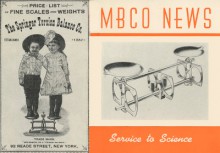The Torsion balance company

At the turn of the last century, the Christian Becker Company and the Springer Torsion Balance Company combined to form THE TORSION BALANCE COMPANY. The precision analytical balance of today, based on contributions made by the Becker family, is the finest instrument of its kind ever developed. The torsion balance has no knife edges and eliminates friction by supporting the beam of a balance on tightly stretched metal bands. One of the most enduring signs of all recorded history is the scales or balance – a symbol of Justice, Trurh, Commerce and Science.
Today’s balance, however, is a precise scientific instrument vastly different from the crude scales pictured with stars of the zodiac and ancient statuary.
Scientific progress is closely linked with the steady advance in the refinement of measuring instuments used in research. Present day physical and chemical sciences had their begining in advent of the precision laboratory balance little more that 150 years ago.
In the nineteenth century, new developments in precision weighing came thick and fast. Justin von Liebeg created a precise long beam balance. Weights were standardized at about the time of the French Revolution. In the United States, in 1835, Christopher Becker and his two sons, Ernest and Christian, began the manufacture of analytical balances and weights. Then in 1882, a new balance based on the torsion principle (see Cover) was patented.
The balances have been designed to carry heavy loads with a high degree of accuracy. Their range extends down to fine prescription weighing as well as laboratory use where a high ratio of accuracy and capacity is necessary.
Extremely feeble forces of attraction and repulsion, such as those involved in measuring the gravitation constant, radiation pressure and Coulomb’s laws, have also employed the torsion principle to obtain a very high degree of accuracy and sensitivity.
Published in 1960 (MBCO News)
